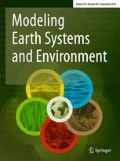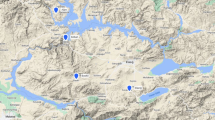Abstract
Evapotranspiration (ETo) is one of the most important variables of the water cycle when water requirements for irrigation, water resource planning or hydrological applications are analyzed. In this context, models based on artificial neural networks (ANN) of the retro-propagation type can be an alternative method to estimate ETo in highland regions using a number of input variables limited. The objective of this study is to develop ANN models to estimate ETo for the Peruvian highlands using input variables such as maximum air temperature (Tmax), minimum air temperature (Tmin), hours of sunshine (Sh), relative humidity (Rh) and wind speed (Wv), as an alternative method to FAO Penman–Monteith method (FAO-PM56) and Hargreaves–Samani (HS). Daily climatic datasets recorded at 12 meteorological stations between 1963 and 2015 were selected in this study. For evaluation reason, the ETo calculated using the FAO-PM56 was also considered. The main input variable to ANN modeling is Tmax, followed by Sh and Wv or combinations between them. Hargreaves–Samani (HS) showed a poor performance in the estimation of the ETo in the Peruvian highlands compared to the 13 ANN models. Additionally, it was determined that in stations with lower thermal amplitude (< 14.2 °C) the lowest performance levels are presented in the estimation of the ETo with HS equation, which does not occur markedly with the ANN models that they estimate adequately ETo. Therefore, ANN models represent a great option to replace the FAO-PM56 and HS method, when ETo data series are scarce.





Similar content being viewed by others
References
Aceituno P (1996) Elementos del Clima en el Altiplano Sudamericano. Revista Geofísica-IPGH 44:37–55
Adamala S (2018) Temperature based generalized wavelet-neural network models to estimate evapotranspiration in India. Inf Process Agric 5:149–155. https://doi.org/10.1016/j.inpa.2017.09.004
Adeloye AJ, Rustum R, Kariyama ID (2012) Neural computing modeling of the reference crop evapotranspiration. Environ Model Softw 29:61–73. https://doi.org/10.1016/j.envsoft.2011.10.012
Allen RG (2000) Using the FAO-56 dual crop coefficient method over an irrigated region as part of an evapotranspiration intercomparison study. J Hydrol 229:27–41. https://doi.org/10.1016/S0022-1694(99)00194-8
Antonopoulos VZ, Antonopoulos AV (2017) Daily reference evapotranspiration estimates by artificial neural networks technique and empirical equations using limited input climate variables. Comput Electron Agric 132:86–96. https://doi.org/10.1016/j.compag.2016.11.011
Binford MW, Kolata AL, Brenner M, Janusek JW, Seddon MT, Abbott MB, Jason H (1997) Climate variation and the rise and fall of an Andean civilization. Quat Res 47:235–248
Chang Y, Wang J, Qin D, Ding Y, Zhao Q, Liu F et al (2017) Methodological comparison of alpine meadow evapotranspiration on the Tibetan Plateau, China. PLoS One 12(12):e0189059. https://doi.org/10.1371/journal.pone.0189059
Citakoglu H, Cobaner M, Haktanir T, Kisi O (2014) Estimation of monthly mean reference evapotranspiration in Turkey. Water Resour Manag 28:99–113. https://doi.org/10.1007/s11269-013-0474-1
Cobaner M (2011) Evapotranspiration estimation by two different neuro-fuzzy inference systems. J Hydrol 398:292–302. https://doi.org/10.1016/j.jhydrol.2010.12.030
Droogers P, Allen RG (2002) Estimating reference evapotranspiration under inaccurate data conditions. Irrigat Drain Syst 16(1):33–45. https://doi.org/10.1023/A:1015508322413
Falamarzi Y, Palizdan N, Huang YF, Lee TS (2014) Estimating evapotranspiration from temperature and wind speed data using artificial and wavelet neural networks (WNNs). Agric Water Manag 140:26–36. https://doi.org/10.1016/j.agwat.2014.03.014
Feng Y, Peng Y, Cui N, Gong D, Zhang K (2017) Modeling reference evapotranspiration using extreme learning machine and generalized regression neural network only with temperature data. Comput Electron Agric 136:71–78. https://doi.org/10.1016/j.compag.2017.01.027
Garcia M, Raes D, Jacobsen SE (2003) Reference evapotranspiration and crop coefficient of quinoa (Chenopodium quinoa Willd) in the Bolivian Altiplano. Agric Water Manag 60:119–134
Garcia M, Raes D, Allen R, Herbas C (2004) Dynamics of reference evapotranspiration in the Bolivian highlands (Altiplano). Agric For Meteorol 125(1–2):67–82. https://doi.org/10.1016/j.agrformet.2004.03.005
Garcia M, Raes D, Jacobsen SE, Michel T (2007) Agroclimatic constraints for rainfed agriculture in the Bolivian Altiplano. J Arid Environ 71:109–121
Garreaud R, Vuille M, Clement C (2003) The climate of the Altiplano: observed current conditions and mechanisms of past changes. Palaeogeogr Palaeocl 194:5–22. https://doi.org/10.1016/S0031-0182(03)00269-4
Garreaud RD, Vuille M, Compagnucci R, Marengo J (2009) Present day South American climate. Palaeogeogr Palaeocl 281:180–195
Günther F, Fritsch S (2010) Neuralnet: training of neural networks. R J 2(1):30–38
Haykin S (1999) Neural networks: a comprehensive foundation. Pearson Education, Delhi
Huang H, Han Y, Cao M, Song J, Xiao H (2016) Spatial-temporal variation of aridity index of China during 1960–2013. Adv Meteorol 2016:1–10. https://doi.org/10.1155/2016/1536135
Huo Z, Feng S, Kang S, Dai X (2012) Artificial neural network models for reference evapotranspiration in an arid area of northwest China. J Arid Environ 82:81–90. https://doi.org/10.1016/j.jaridenv.2012.01.016
Ihaka R, Gentleman R (1996) R: a language for data analysis and graphics. J Comput Graph Stat 5(3):299–314
Jain SK, Nayak PC, Sudheer KP (2008) Models for estimating evapotranspiration using artificial neural networks, and their physical interpretation. Hydrol Process 22:2225–2234. https://doi.org/10.1002/hyp.6819
Jolliffe IT (2002) Principal component analysis. Springer, New York. https://doi.org/10.1007/b98835
Kişi Ö (2006) Generalized regression neural networks for evapotranspiration modelling. Hydrol Sci J 51:1092–1105. https://doi.org/10.1623/hysj.51.6.1092
Kumar M, Bandyopadhyay A, Raghuwanshi NS, Singh R (2008) Comparative study of conventional and artificial neural network-based ETo estimation models. Irrig Sci 26:531–545. https://doi.org/10.1007/s00271-008-0114-3
Laaboudi A, Mouhouche B, Draoui B (2012) Neural network approach to reference evapotranspiration modeling from limited climatic data in arid regions. Int J Biometeorol 56:831–841. https://doi.org/10.1007/s00484-011-0485-7
Laqui W (2010) Aplicación de Redes Neuronales Artificiales a la Modelización y Previsión de Caudales Medios Mensuales del Rio Huancané. Revista Peruana Geo-Atmosférica (RPGA), SENAMHI-Perú 2:30–44
Liu Z, Peng C, Xiang W, Deng X, Tian D, Zhao M, Yu G (2012) Simulations of runoff and evapotranspiration in Chinese fir plantation ecosystems using artificial neural networks. Ecol Model 226:71–76. https://doi.org/10.1016/j.ecolmodel.2011.11.023
Lujano E, Felipe O, Lujano A, Quispe J (2015) Validación de la precipitación estimada por satélite TRMM y su aplicación en la modelación hidrológica del rio Ramis Puno Perú. Revista de Investigaciones Altoandinas 17:2. https://doi.org/10.18271/ria.2015.116
Núñez L, Grosjean M, Cartagena I (2002) Human occupations and climate change in the Puna de Atacama, Chile. Science 298:821–824
Petković D, Gocic M, Trajkovic S, Shamshirband S, Motamedi S, Hashim R, Bonakdari H (2015) Determination of the most influential weather parameters on reference evapotranspiration by adaptive neuro-fuzzy methodology. Comput Electron Agric 114:277–284. https://doi.org/10.1016/j.compag.2015.04.012
Pillco Zolá R, Bengtsson L, Berndtsson R, Martí-Cardona B, Satgé F, Timouk F, Bonnet M, Mollericom L, Gamarra C, Pasapera J (2018) Modeling Lake Titicaca daily and monthly evaporation. Hydrol Earth Syst Sci Discuss. https://doi.org/10.5194/hess-2018-127
Rahimi Khoob A (2008) Artificial neural network estimation of reference evapotranspiration from pan evaporation in a semi-arid environment. Irrig Sci 27:35–39. https://doi.org/10.1007/s00271-008-0119-y
Rau P, Bourrel L, Labat D, Frappart F, Ruelland D, Lavado W, Dewitte B, Felipe O (2017) Hydroclimatic change disparity of Peruvian Pacific drainage catchments. Theor Appl Climatol 10:100. https://doi.org/10.1007/s00704-017-2263-x
Roche M, Bourges J, Cortes J, Mattos R (1992) Climatology and hydrology of the Lake Titicaca basin. In: Dejoux C, Iltis A (eds), Lake Titicaca: a synthesis of limnological knowledge. Kluwer Academic, Dordrecht, vol 68, pp 63–88 (Monographiae Biologicae). ISBN 0-7923-1663-0
Shiri J (2017) Evaluation of FAO56-PM, empirical, semi-empirical and gene expression programming approaches for estimating daily reference evapotranspiration in hyper-arid regions of Iran. Agric Water Manag 188:101–114. https://doi.org/10.1016/j.agwat.2017.04.009
Tabari H, Hosseinzadeh Talaee P (2013) Multilayer perceptron for reference evapotranspiration estimation in a semiarid region. Neural Comput Appl 23:341–348. https://doi.org/10.1007/s00521-012-0904-7
Traore S, Wang Y-M, Kerh T (2010) Artificial neural network for modeling reference evapotranspiration complex process in Sudano-Sahelian zone. Agric Water Manag 97:707–714. https://doi.org/10.1016/j.agwat.2010.01.002
UNESCO (2003) Water for people, water for life. UNESCO, New York
Wu W, Dandy GC, Maier HR (2014) Protocol for developing ANN models and its application to the assessment of the quality of the ANN model development process in drinking water quality modelling. Environ Model Softw 54:108–127. https://doi.org/10.1016/j.envsoft.2013.12.016
Yassin MA, Alazba AA, Mattar MA (2016) Artificial neural networks versus gene expression programming for estimating reference evapotranspiration in arid climate. Agric Water Manag 163:110–124. https://doi.org/10.1016/j.agwat.2015.09.009
Zanetti SS, Sousa EF, Oliveira VP, Almeida FT, Bernardo S (2007) Estimating evapotranspiration using artificial neural network and minimum climatological data. J Irrig Drain Eng 133:83–89. https://doi.org/10.1061/(ASCE)0733-9437(2007)133:2(83)
Zolá RP, Bengtsson L (2006) Long-term and extreme water level variations of the shallow Lake Poopó, Bolivia. Hydrol Sci J 51:98–114. https://doi.org/10.1623/hysj.51.1.98
Zubieta R, Laqui W, Lavado W (2018) Modelación hidrológica de la cuenca del río Ilave a partir de datos de precipitación observada y de satélite, periodo 2011–2015, Puno-Perú. Revista de Tecnología y Ciencias del Agua
Acknowledgements
The authors would like to thank Servicio Nacional de Meteorología e Hidrología (SENAMHI) for providing us the climatic information used in this investigation. They also would like to acknowledge Programa de Doctorado en Recursos Hídricos of the Universidad Nacional Agraria La Molina for providing support in the development of this research.
Author information
Authors and Affiliations
Corresponding author
Ethics declarations
Conflict of interest
This statement is to certify that all Authors have contributed significantly to the work, have read the manuscript, attest to the validity and legitimacy of the data and its interpretation, and agree to its submission to the Neural Computing & Applications Journal. We warrant that the article is the Authors’ original work. We warrant that the article has not received prior publication and is not under consideration for publication elsewhere. All authors agree that author list is correct in its content and order and that no modification to the author list. Therefore, we have no conflicts of interest to disclose. On behalf of all Co-Authors, the corresponding Author shall bear full responsibility for the submission.
Additional information
Publisher's Note
Springer Nature remains neutral with regard to jurisdictional claims in published maps and institutional affiliations.
Electronic supplementary material
Below is the link to the electronic supplementary material.
Rights and permissions
About this article
Cite this article
Laqui, W., Zubieta, R., Rau, P. et al. Can artificial neural networks estimate potential evapotranspiration in Peruvian highlands?. Model. Earth Syst. Environ. 5, 1911–1924 (2019). https://doi.org/10.1007/s40808-019-00647-2
Received:
Accepted:
Published:
Issue Date:
DOI: https://doi.org/10.1007/s40808-019-00647-2




